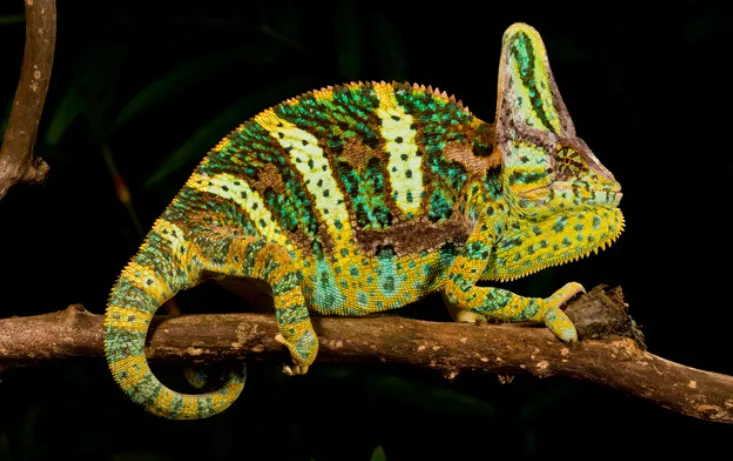
Table of Contents
Scientific Classification
- Kingdom: Animalia
- Phylum: Chordata
- Class: Reptilia
- Order: Squamata
- Suborder: Iguania
- Family: Chamaeleonidae
- Genus: Chamaeleo
- Species: C. calyptratus
Quick Overview
Veiled Chameleon (Chamaeleo calyptratus), also known as the Yemen Chameleon, is a distinctive and highly sought-after species due to its striking appearance and casqued (helmet-like) head. Native to Yemen and Saudi Arabia, they are now found in reptile collections worldwide.
Fast Facts
- Scientific Name: “Chamaeleo calyptratus”
- Lifespan: 6-8 years in captivity
- Average Size: Males: 18-24 inches; Females: 10-14 inches
- Diet: Insectivorous, occasionally herbivorous
- Habitat: Mountainous regions in Yemen and Saudi Arabia
Did you know?
The casque on the veiled chameleon’s head aids in directing water from rain or dew straight to its mouth.
Appearance
Their primary color is green, but they have striking bands of gold, blue, and yellow, which become more pronounced with age. The tall casque on their heads is a defining feature, more prominent in males.
Size and Weight
Male Veiled Chameleons typically measure between 14 to 18 inches, while females range from 10 to 14 inches. Weight aligns with these dimensions.
Temperament and Behavior
They are solitary and can be territorial, especially males. Their mood or health can be gauged by their color changes. For example, dark colors might indicate stress.
Fun Fact:
Their eyes move independently, enabling them to look in two directions at once – a vital adaptation for hunting and watching for predators.
Habitat and Distribution
Originally from Yemen and Saudi Arabia, Veiled Chameleons inhabit mountainous areas where conditions can vary from cool to warm.
Care Guide
For those considering a Veiled Chameleon as a pet:
- Vertical cages with plenty of branches are essential for climbing.
- Humidity levels of 50-70% are ideal.
- They need UVB lighting for calcium absorption.
- Diet should comprise insects, with occasional fruits and vegetables.
- Frequent misting ensures they remain hydrated.
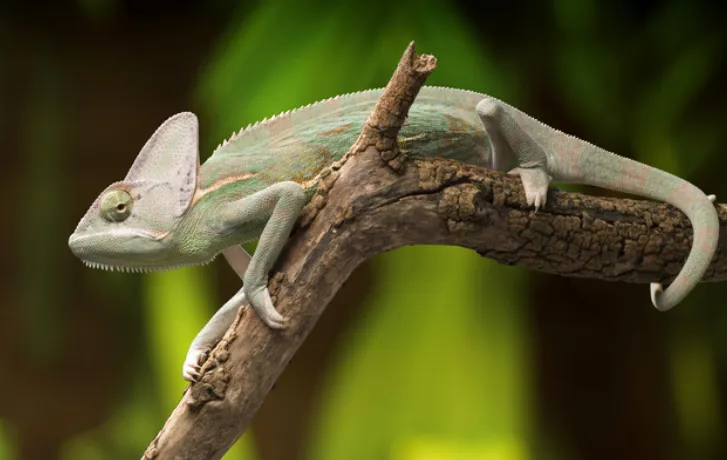
Diet and Nutrition
While primarily insectivores feasting on crickets, locusts, and similar insects, mature chameleons, especially females, might also consume plant matter, including leaves and fruits. Calcium and vitamin supplements are essential.
Health and Wellness
Common concerns include dehydration, vitamin A deficiency, and metabolic bone disease. It’s important to seek a reptile-specialized vet for regular check-ups.
Breeding
After mating, female Veiled Chameleons lay a clutch containing up to 30-70 eggs in a damp substrate. These eggs take around 6-9 months to hatch, dependent on conditions.
Conservation Status
While not classified as endangered, habitat loss and the pet trade can affect their wild populations.
Fun Fact:
Veiled Chameleons have a rapid-fire tongue, which they use to capture prey, extending almost double their body length in a split second.
Photo Gallery

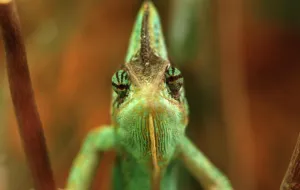
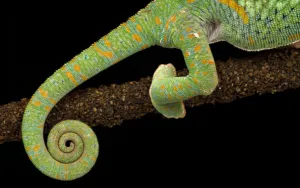
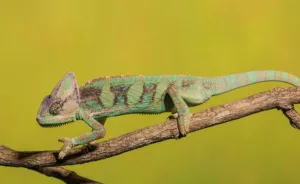
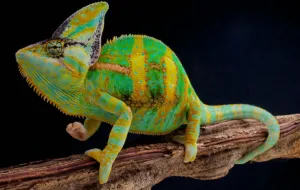

Check out the video below of a baby Veiled Chameleon hissing:
Related Profiles
- Panther Chameleon
- Jackson’s Chameleon
Share This Profile:
3 Amazing Facts About Veiled Chameleon
- Versatile Diet: Apart from insects, adult Veiled Chameleons can consume leaves, flowers, and fruit, making them one of the few partially herbivorous chameleon species.
- UV Vision: They can perceive UV light, allowing them to spot insects and predators, which might be invisible to the human eye.
- Temperature Regulators: By altering their colors, they can regulate their body temperature. Dark colors absorb more sunlight, while light colors reflect it.
- Enchi Ball Python: A Unique and Stunning Morph of Python regius - March 27, 2025
- Emerald Tree Monitor: The Enigmatic Green Guardian of the Rainforest - March 26, 2025
- The Egyptian Cobra (Naja haje): A Fascinating Serpent - March 25, 2025
